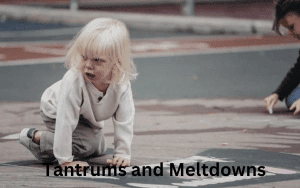Tips for Dealing with Your Child’ Tantrums and Meltdowns
 This is essential advice for teaching kids how to control their feelings. Tantrums and Meltdowns are taxing for both parents and children. Children experience them when overwhelmed by intense feelings they cannot control.
This is essential advice for teaching kids how to control their feelings. Tantrums and Meltdowns are taxing for both parents and children. Children experience them when overwhelmed by intense feelings they cannot control.
Frustration and anger are frequent precipitants. Despite neither term having any clinical meaning, meltdowns are sometimes seen as more intense forms of tantrums by parents.
Child’ Tantrums and Meltdowns
Beyond the preschool years, tantrums and meltdowns may be signs of deeper issues in children. Tantrums are a common symptom of extreme anxiety.
Outbursts are common among children with ADHD because they lack impulse control and struggle to deal with boredom. Children with learning disabilities who go untreated often act out in rage.
Many autistic children have meltdowns whenever their routine is disrupted. Meltdowns are a typical result of sensory overload, especially in children with trouble processing information.
Whatever the reason, children who frequently lose their temper show a lack of emotional regulation abilities. Problem-solving, expressing needs, and controlling emotions are common areas of difficulty for them.
It can be difficult for parents to know what to do when their child has a tantrum or meltdown. It’s standard practice to appease a child’s tantrum by granting their wishes, such as handing a weeping youngster a toy.
However, teaching a youngster that weeping will get them what they want just encourages more crying and tantrums in the future. Instead, try to identify your child’s behavioral triggers and guide them toward healthier emotional outlets.
The Science of Early Years Resilience
kids as Mini-Versions of Their Parents
These days, many of us raise our kids to be mini-versions of ourselves. Since we have long forgotten what it’s like to be a youngster, our adult perspective leads us to misinterpret their actions.
Therefore, it’s hard for us grownups to empathize when our kid has a tantrum because their sandwich was cut incorrectly. Our response is, “Eat your sandwich; other kids have nothing to eat.”
Alternatively, “It ends up in your belly anyway; just eat it.” We try to apply logic to a little human undergoing a profound emotional experience, but it seldom works.
The brain of a kid is not entirely formed. Therefore, a youngster is not a little adult; in reality, a human brain completes its development in its mid to late twenties.
During adolescence, the prefrontal cortex, the most recent part of the brain to evolve, undergoes significant development. This region controls executive functions of the brain, such as decision-making, emotion regulation, planning, clear thinking, and setting priorities.
Individuals can make more complex decisions and regulate emotions more effectively as the prefrontal cortex matures.
This development is crucial for successfully navigating social situations, academic performance, and overall well-being.
Your kid is not a miniature you, complete with an adult’s level of mental maturity. Your child’s brain is still developing and isn’t ready to think and control like an adult’s.
We have no trouble comprehending that a 6-month-old baby’s inability to walk is typical and expected. Emotional regulation is a complex topic; we must be more patient and less demanding.
Having two small children of my own, I well understand. We want kids to quit throwing tantrums so desperately that we respond in ways that aren’t really helpful.
We have a problem with the “bad” behaviors that follow rage and agree that discipline is necessary.
Some Methods to Build an Unbreakable Bond With Your Children
Temper Tantrums Have a Place in a Child’s Development


Your child’s brain is still developing, so he or she can’t suddenly “calm down.” Suppose you’ve ever witnessed a toddler cease throwing a tantrum after receiving a severe punishment.
In that case, you know that rather than learning how to manage their emotions, the child shuts down. Remember that your child’s tantrums or meltdowns don’t make them a terrible kid or spoilt.
It’s normal for children to have tantrums, breakdowns, and other expressions of anger as they grow up. They need to gain the maturity and experience to self-regulate effectively.
They must be taught these skills as their brains expand and develop. The brain’s emotional center, the limbic system, develops primarily in early children.
Young children have an emotional prism through which they view the world and respond to ordinary events.
But if you see that your child’s tantrums are increasing more frequent or severe, or if they are different from the tantrums of other children their age, you may want to consult a specialist.
Meltdowns vs. Tantrums
Although neither tantrums nor meltdowns are technically clinical terms, many people see a distinction between the two.
The word “tantrum” is typically reserved for less severe episodes when the youngster still shows signs of being in control of their behavior. Many parents utilize the fact that a tantrum tends to fade away when no one is watching as a benchmark.
In contrast, a meltdown is a complete loss of self-control that can only be stopped by the child’s exhaustion or the parent’s ability to restore calm.
Whether moderate or severe, tantrums are signs that a youngster has difficulty controlling their emotions. According to Dr. Steven Dickstein, a child and adolescent psychiatrist, anger is the primary emotion that drives youngsters to lose control and explode.
The child’s indignation and sense of unfairness are magnified when they are denied what they feel they need or deserve, such as a cookie, a video game, or a toy.
Anxiety, however, is another major catalyst; it leads children to panic and overrides the reasoning that would help them understand that their fear is unfounded.
Your Child’s Tantrum is a Sign That He or She is Emotionally Overwhelmed.
A tantrum, like any other behavior, is a form of expression. The children are talking to each other during their temper. They require the help of a level-headed adult when their emotions overwhelm them.
Think about the lesson you’re attempting to teach your child at that exact moment when he or she is throwing a tantrum. You should avoid demonstrating that shouting is effective communication or that dismissing someone else’s feelings is beneficial.
I have no doubt that you want to assist your child in learning to control their feelings and express themselves.
They look to us for guidance on what to do when they feel out of control since we serve as role models for them in dealing with stressful situations. Furthermore, it is critical to question, “What do I want to teach my child to do when stressed?”
Factors


There isn’t one single reason why some kids don’t learn to control their emotions as they grow up. Medical professionals do not recognize these terms: tantrum disorder and meltdown disorder.
Dr. Dickstein says. We can’t end tantrums and meltdowns unless we figure out what’s causing them, just like we can’t end a fever unless we know what’s causing it.
The inability to control one’s feelings may indicate a deeper issue. Frequent tantrums can be brought on by a variety of factors, including:
ADHD
More than 75% of children who presented with significant temper outbursts also meet the criteria for ADHD, according to a new study by Amy Roy, PhD, of Fordham University.
While a history of violence may indicate the presence of behavioral issues in a child, it is essential to note that such behavior does not always stem from a diagnosis of ADHD.
Several factors could contribute to violent behavior in children; a healthcare professional can determine what is causing violent behavior. And guide the development of an effective treatment plan.
According to Vasco Lopes, PsyD, a clinical psychologist, individuals don’t realize that inattention, procrastination, and boredom can add to the buildup, leading to violent outbursts. To solve a problem, you need to find its root.
Teach Your Children How to Communicate With Others? or Communication Skills for Your Loves One
Anxiety
Anxiety also has a significant role. Children may not have an anxiety condition, but they may still have trouble with stress and have meltdowns when faced with events that trigger their fears.
Children with undetected learning difficulties, those who have experienced trauma or abuse, or those who have not been adequately nurtured may have such a reaction.
Learning Disability
Your child may have an undetected learning disability if they display disruptive behavior at school or when completing homework regularly. Let’s pretend they struggle greatly in mathematics and that any mathematical difficulties immediately set off their temper.
They could shred up an assignment or start a project with another kid as a distraction from their problems rather than seek assistance.
Depression
Some children who experience frequent and severe tantrums often suffer from depression and irritability. Children who experience extreme tantrums interspersed by periods of intense irritation are said to suffer from a new illness known as disruptive mood dysregulation disorder, or DMDD.
Dr. Lopes argues that children who are easily angered are like water heated to 90 degrees: perpetually on the verge of boiling. These children’s parents must constantly tread carefully to avoid upsetting their sensitive young minds when things don’t go their way.
Autism


Children on the autism spectrum frequently have outbursts of extreme emotion. These kids are inflexible; they need their regular schedule to function emotionally, and any disruption to that habit might cause them distress. As a result, individuals might be unable to adequately communicate their needs and wants.
Sensory Processing Issues:
Children diagnosed with autism and (ADHD) often experience difficulties in processing sensory information, resulting in sensory overload and uncontrolled emotional outbursts.
The underlying mechanism of this sensory processing dysfunction remains unclear and requires further investigation. Nonetheless, it poses significant challenges for parents, educators, and clinicians who work with these children as they navigate their daily routines.
Understanding the sensory processing patterns in these children and developing appropriate interventions can empower you to live your best life by enhancing your ability to fully participate in social, academic, and family activities. Take the necessary steps to improve your quality of life today.
How ‘Helicopter’ Parents Cause the Mental Health Crisis in Today’s Young Generation?
Inadequate Abilities
Most mental health practitioners feel that children who frequently experience emotional outbursts, regardless of reason, lack the skills necessary to effectively manage circumstances that provoke negative emotions. Those things are:
- the ability to restrain one’s impulses
- Resolving Issues
- Putting off pleasure
- Negotiating
- Sharing your wants and desires with an adult
- Recognizing proper behavior in any given circumstance
- Self-soothing
- Infinite loop
Dr. Dickstein observes that parents often overestimate their children’s agency regarding their tantrum behavior. This, however, does not disprove the possibility of taught behavior.
Children with significant temper problems don’t plan to throw tantrums, but they may have learned from adults that doing so is adequate. “Tantrums in kids indicate a lag in emotional regulation skills, which worsens due to conditioned learning,” according to Dr. Lopes.
A youngster may believe throwing a tantrum is the best method to achieve what he wants if he confronts a problem and has no other way of resolving it.
As Dr. Lopes puts it, “it becomes a vicious cycle” since the children are not acquiring the adaptive skills that children typically acquire to work together to solve issues but rather are practicing maladaptive reactions when they grow irritated. And as they keep honing those abilities, they become more confident using them in other scenarios.
4 Ways That Break Sibling’s Relationship, and 4 Reasons Reconciliation Is So Hard
What Causes Toddlers to Lose Their Temper?
Toddlers may throw tantrums if they cannot handle strong emotions like anger and frustration. Sometimes, other issues like anxiety, attention deficit hyperactivity disorder, or learning disabilities can also contribute to these outbursts.
It is essential to understand that different children have different needs, so the language should be simple and straightforward. Sentences should be short and direct, with only necessary information.
Using everyday language instead of jargon or legal terms can make the text easier to understand. The active voice should be used whenever possible, as it helps make the meaning clear. Your child may benefit from visiting a professional if they continue having frequent tantrums beyond preschool.
Suggestions for Dealing With Tantrums Are Provided Below.


1. Before a Tantrum:
A. Investigate the Origins of Your Child’s Outbursts.
Sometimes, it’s obvious when your kid wants that new toy you saw at the shop. Sometimes, the true motivation behind the tantrum is obvious, such as when your child just needs you to pay attention to him or her.
Four typical triggers for temper tantrums have been identified by the National Association of School Psychologists.
- To show your annoyance at having to do something (like tie your shoes or use scissors)
- to get a rise out of your parents or other adults
- to get a reward, such as a snack or a new toy
- Do not do something like go home or put away the toys.
Keep a weekly journal if you want to figure out why your youngster is throwing tantrums. Take into account the circumstances before your youngster begins to have tantrums. You should see a trend after a week or two.
Then, consider how you may improve your child’s ability to deal with these recurring challenges. If, for some reason, your child usually throws a fit right before bath time, try not to ruin his or her mood by taking them out of their favorite pastime.
So that she isn’t actively playing when you announce bath time, you may want to steer your kid towards a peaceful, relaxing activity (such as reading books or listening to music).
B. Keep an Eye Out For Warning Indicators of Impending Emotional Outbursts.
Knowing what sets off your child’s tantrums can allow you to be on the lookout for warning indicators. This way, you can prevent the matter from escalating further.
Your child may have a tantrum if, for instance, you have to pull her away from the park abruptly. If that’s the case, make sure she knows to pack her bags well in advance. You may say, “We need to go in just a minute. Before we depart, do you want to take one more swing?
Kids With These 10 Habits Have ‘Highly Sensitive’ Brains—Why Parenting Experts Say it is Very Good.
2. When a Tantrum First Starts:
A. Respond Calmly to Your Child’s Requests.
The most important thing is to prove that you get it. You may say, “I can tell you’re craving a cookie. However, dinner comes first.
B. Show Her That Throwing a Tantrum Isn’t the Way to Get Her Way.
Say, “We can’t obtain what we want by whining, kicking, and screaming. After supper, if you beg me politely, I might give you a cookie.
C. To Prevent a Tantrum, Try Diverting Your Child’s Attention.
You can divert her attention by shifting the conversation or removing her from her current setting. This is an effective strategy for preventing a public meltdown.
However, you may need to clear your youngster from the public stage if distraction fails. It could be better to leave the grocery store with a full cart. Remember that by not giving in to your child’s tantrums, you are sending a strong message that you mean business.
3. While Throwing a Tantrum:
A. Don’t Bother Trying to Persuade Her. You Should Just Disregard the Behavior.
When a youngster is having a tantrum, no one can talk sense into them. Don’t look at her or acknowledge her presence. Giving in to the child’s attention demands will only worsen the tantrum.
B. Only Intervene if Absolutely Required, and Keep Your Emotions in Check.
It’s not always feasible to disregard a child’s tantrum. You will need to intervene if your kid can get what she wants or is in danger because of her temper.
A time-out allows you to redirect your kid to a peaceful, neutral area where she may collect herself. Make sure nothing is entertaining or engaging at the time-out location. Allow your kid to resume whatever she did once quiet and calm for 15 seconds.
Don’t let your own wrath get the best of you when intervening. Anger is a way to get your child’s attention. It reassures her that she need not suppress her feelings. She has to gain self-control skills so she won’t act irrationally.
C, Stay Strong and Don’t Give Up
If you give in to your child’s tantrums, she will learn they are effective. This is a practiced habit. Refocusing her can be very challenging after a youngster has acquired this tactic.


4. After a Fit of Temper:
A. Quickly Express Your Delight in Your Youngster for Calming Down.
This praise will encourage her to continue practicing self-control and settling her nerves. Make sure your youngster still finishes the assignment, though, if the reason for the tantrum was to avoid doing it.
B. Discuss Your Child’s Frustrations and Anger at a Later Time.
Give her a hand in regulating her intense emotions. You can show them how to use techniques like deep breathing, counting to ten, and expressing themselves verbally. To express your frustration to your youngster, you may say, “I’m becoming so upset! I need to take a deep breath and count to 10 to relax. Can you lend a hand?
Effects of Social Media on Teen Mental Health: A Missing Link
5, Parenting is of Utmost Importance.
No matter the origin, psychologists agree that the first step in treating outbursts is identifying triggers and experimenting with techniques to alter the environment to lessen the frequency of outbreaks. Parents are best positioned to determine what changes must be made to their child’s environment.
Dr. Dickstein explains, “We don’t blame parents for tantrums” because parents are only one factor in a child’s behavior patterns, including temperament and development. Changing parental behavior is the most effective intervention we can use with young children.
6, Take Control of Your Emotional Responses.
Perhaps you were never shown how to properly control your emotions as a child, and as a result, you have a hard time keeping your cool when your child is angry.
Managing through a tantrum is even more challenging when you’re already overwhelmed by work, housework, and life. And the timing of tantrums is never convenient, coming as they do when everyone in the house is already overworked and worried.
If your child is having a tantrum, rather than concentrating on soothing them down, try to control your own response and emotions.
Find your center and steady yourself. Practicing techniques like taking deep breaths and telling yourself this is normal, age-appropriate behavior might help.
They might be sleepy, hungry, unwell, going through a change, or still angry about something that happened earlier. Co-regulation occurs when your physiological state of calm induces a similar form of peace in the youngster.
Try looking up tactics and advice online or seeing a professional if you need help keeping yourself in check. No one can teach their children self-control if they can’t learn to relax.
7, Honor Your Child’s Emotions.
If your child is having a meltdown, use the time to teach them about their feelings and how to label them.
Saying something like, “I know you are upset because I cut your sandwich the wrong way,” or “I know you are disappointed because you can’t get a toy today,” may help a child recognize and name their feelings, as well as reassure them that you understand and care about them.
If people are dissatisfied because the sandwich wasn’t sliced the way they requested, it doesn’t mean we have to cave into their demands. We shouldn’t cave in after initially saying “no,” as doing so may encourage further tantrum-throwing.
We’re just being there for them while they figure out how to deal with all the complicated feelings this event has prompted.
Some Wonderful & Creative Ideas to Support Anxious Kids
8, Keep in Touch
Keeping in touch with your child through the ups and downs of life is an illustration of the preceding advice. Removing the stigma associated with challenging emotions begins with letting your child know that you love them regardless of their feelings.
Then, when they’re feeling overwhelmed, they may learn to self-regulate with your help. Some children may desire to be held, while others prefer to play independently or kick and scream at you.
You should tell them you will be there for them whenever they are ready. Keep them out of harm’s path and ensure their safety.
We can help our kids more and provide for their needs if we learn to keep ourselves in check. Keeping calm and connected with our kids at trying times offers teaching opportunities.
We reassure them that feeling emotions is a natural aspect of being human and that letting emotions serve as messengers without having them control our actions is okay.
After you and your kid have calmed down, discuss what happened and any appropriate consequences. You can advise them on self-soothing methods, such as deep breathing and relaxation exercises, that they can use the next time they feel sad and furious.
Ask them if they have any ideas on what they can do the next time they feel their emotions getting the best of them.
A Meltdown / Breakdown? Here Are Ways to Cope.


1. Just Before Losing it:
A. Find Out What Brings on Your Child’s Tantrums.
Sensory difficulties, such as being overstimulated by a noisy and chaotic environment, might serve as triggers. Anxiety, depression, and irritability can all be triggered by exhaustion, irritation, abrupt changes, or boredom. Those who have autism spectrum disorders may greatly benefit from identifying potential triggers.
Says psychologist Mark Hutten. Keep a weekly journal if you want to figure out what sets off your child’s tantrums. Take into account the context of your child’s meltdowns.
B. Once You’ve Identified a Trigger, You Can Take Steps to Mitigate its Effects.
Your youngster, for instance, may experience sensory overload if you take him or her shopping. If so, consider making many shorter excursions to the store.
Altering your child’s regular schedule may cause tantrums or other behavioral issues. If so, prepare your youngster for any upcoming changes in their routine well in advance. Let him bring a special toy or anything that helps him feel at ease.
2. When a Breakdown Occurs:
- Assist your youngster in locating a peaceful spot where he may cool down in safety. Try reducing or removing the offending factor if it’s a sensory meltdown.
- For instance, if your youngster seems overwhelmed by loud noises and bright lights, try removing him to a calm, dark room.
- Stay with your child if he or she is having a tantrum. Be a source of peace and reassurance.
- Limit your conversations with your kid. The breakdown may be prolonged because of the added stimuli.
- You might not want to touch or hug your child if he is undergoing a sensory meltdown.
- Listen to your child’s cues about whether or not he wants to be touched. Sit calmly next to him if holding or touching him stresses him out.
- Don’t scold your kid if he or she has a tantrum. During a meltdown, he loses all self-control.
3. Following A Breakdown:
Eventually, You’ll want to talk with your kid about his or her emotions and how to handle them. Help him find the right words to describe how he feels. You may lead by example in showing emotion, too. Call out intense emotions (such as worry or anger) by name and explain what’s causing them.
Then, serve as an example by doing something to control your emotions. Say something like, “Everyone seems to be moving so quickly that I’m starting to feel worried and terrified. I have to take a break and relax my muscles.
Make sure your child with frequent outbursts has a calm, secure space where he can go when he needs to calm down. A blanket and pillow fort is one option. Or it could be a comfy bean bag in a corner of his room.
Meltdowns are often a normal response to our busy lifestyles. If you have any reason to believe this, take it easy. When planning your child’s day, provide plenty of time for smooth changes.
For instance, make sure your kid has plenty of time to get dressed in the morning before you head out the door. Maintain a regular daily routine. Make sure to schedule your day with enough events.
Teach your kid how to deal with their feelings. There may be some overlap between the techniques used to deal with temper tantrums and those used to deal with meltdowns.
Emotional regulation is a critical social and emotional ability for kids, and both activities require it. Dynamic management and behavioral self-control. Each box includes a storybook tailored to help your kid learn necessary social and emotional skills such as empathy, turn-taking, and self-control.
When to See a Doctor
Frequent tantrums and meltdowns may result from a medical ailment or developmental disease that has gone untreated, such as autism spectrum disorder or sensory processing disorder.
Make an appointment with your pediatrician for an evaluation if you have concerns about a possible developmental disability or another health issue in your kid. Your child’s primary care physician might recommend a behavioral therapist, psychologist, or psychiatrist specializing in working with children.
Differences Between Typical Temper Fits and Autistic Meltdowns


People with autism often have meltdowns that are misunderstood as tantrums. While many of the symptoms are the same, the reasons are not.
Temper tantrums occur when a person’s wants or needs are unsatisfied. Conversely, meltdowns are distress calls caused by sensory input or emotional intensity overload.
A meltdown experienced by someone with autism might appear to be a giant tantrum to an observer. They often entail stimming behaviors, including rocking, and usually come before indicators of worry or anxiety. During a crisis, some autistic youngsters abscond or retreat to a tiny, confined location.
Autistic meltdowns are the subject of this essay. How to aid someone suffering a meltdown and the distinction between a tantrum and a meltdown are discussed.
A meltdown is an involuntary reaction to sensory or cognitive overload in autistic people. This condition of extreme dysregulation is not behavioral but rather a physiological expression of a neural response.
A youngster with autism may have a meltdown that resembles a temper tantrum but is considerably more severe. After all, the term “meltdown” refers to the catastrophic release of radioactive materials in a nuclear power station.
Meltdowns in people with autism are not exclusive to young children. Breakdowns can affect anybody with autism, including high-functioning adults and older children.
Symptoms of anguish are typically present in autistic people before a meltdown. Subtle ones include nail biting and requests to leave; overt ones include shielding one’s ears.
Recognize that behaviors are not manipulation but a reaction to stress or sensory overload.
Autistic people often resort to stimming (self-stimulatory behaviors) during stress or sensory overload. Rocking, pacing, humming, and
What Is a Meltdown?
A meltdown is an involuntary reaction to sensory or cognitive overload in autistic people. This condition of extreme dysregulation is not a result of abnormal behavior but rather the outward expression of a neurological reaction.
A youngster with autism may have a meltdown that resembles a temper tantrum but is considerably more severe. It is crucial to understand that the term “meltdown” is not just a word but a catastrophic event that can lead to Radioactive materials being released from a nuclear power station.
Awareness and attention to the potential dangers of a meltdown can help prevent a disaster that could have devastating consequences., which can have disastrous consequences.
Adults and older teens can have autistic meltdowns. Even in generally high-functioning individuals, autism can cause breakdowns in older children, teenagers, and adults.
Signs You’re About to Have a Breakdown


A person with autism may display indicators of discomfort before having a meltdown. These can range from overt actions like covering one’s ears with one’s hands to more covert ones like biting one’s nails or begging to leave.
It is crucial to understand that behaviors are not a kind of manipulation but rather a reaction to stress and/or sensory overload.
Stimming
Autistic people often resort to stimming (self-stimulatory behaviors) during stress or sensory overload. Rocking, pacing, humming, and flicking one’s fingers are all examples of stimuli. Stimming is another typical precursor to a meltdown, and it can get worse as the intensity of the anguish does.
An impending meltdown may be signaled by extreme stimming, such as vigorous rocking or smashing the palm into the forehead.
Eloping
Eloping or bolting (running away) is another typical behavioral reaction in autistic youngsters. When confronted with too much stimulation, an autistic person may want to flee the area to help them feel less stressed and anxious.
While this is a healthy coping method, it might backfire if the person isn’t aware of their surroundings.
Warnings of an Autism Breakdown
When extreme feelings become too much to handle, the brain swings into “fight, flight, or freeze” mode. This is an automatic response that the person experiencing it has no control over.
Meltdowns in autistic people can range from mild to severe.
- Biting
- The destructive power of tears
- Foot-stomping
- Hitting
- Kicking
- Leaving no traces behind
- Self-injury can take many forms, including but not limited to banging one’s head, hitting oneself, and tearing out one’s own hair.
- Stimming
- People are throwing and breaking things.
- Cursing, yelling, sobbing, or a deafening scream are all examples of verbal explosions.
- Taking a step back from one’s thoughts
Autism spectrum disorder meltdowns often continue for at least 20 minutes after the triggering event has passed.
A person on the autism spectrum may need some time to calm down after having a meltdown. Give them some room and time to calm down again.
When an autistic person has a meltdown, they typically cannot remember what transpired. Try not to have any sort of conversation in the hours after the breakdown.
Tips for Avoiding an Autism Spectrum Crisis


You can usually avoid it when you know what sets off your meltdown and what symptoms to look out for. However, once a breakdown has begun, it is highly challenging for an autistic person to regain control.
Be Aware of Triggers
Meltdowns are frequently brought on by an excess of stimuli. Lights, noises, fragrances, and even tactile differences (like sock seams) can all play a role. Meltdowns can also be caused by emotional exhaustion or stress.
Your child’s triggers can be avoided or mitigated if you know what they are. Here’s an example:
- Scent-masking essential oils or air fresheners can be used in these situations.
- Headphones that block out ambient noise to help you focus in noisy environments.
- Fabrics that are soft and easily adjusted
- Eyewear designed to filter out sunlight
Heed the Cautions
If you see your kid showing any of these stress indicators, take immediate steps to remove the source of the stress or relocate the child to a more relaxing environment.
- Anxiety, impatience, and stimming are all symptoms of mounting distress. Children at a certain age may be able to express their feelings of being overwhelmed verbally. If you see any of these, don’t hesitate to act.
- A toddler frightened by the bright lights and loud music in a shopping mall may soon relax if moved outside.
- A youngster who is nervous in a group setting may benefit from specific instructions, comfort, and encouragement.
- The individual will likely have a meltdown if an intervention doesn’t happen or doesn’t resolve the issue.
What to Do About a Meltdown With Autism
It might be challenging to maintain control during a full-blown breakdown. Helping someone through an autism meltdown requires you to keep your cool. Co-regulation is beneficial because it creates an atmosphere of safety and serenity.
Because people with autism are all different, there is no universal treatment. To help soothe your kid, consider the following strategies:
- Soothing tunes
- Cool refreshment
- Compression
- An inviting throw
- Inhale deeply
- Put on the shades.
- Distraction
- Compassion and helpfulness
- A much-loved stuffed animal
- Pure oxygen
- Pressure
- hitting soft objects
- Give them a back rub.
- Silence
- Brushing the skin
- Textures
- A bear embrace
- For older kids, there’s the weighted blanket.
It’s crucial that the autistic person and others around them feel safe at all times. Behaviors like running away, violence, self-harm, and yelling should be taken very seriously.
Remove the person to a quiet place until the crisis passes. To prevent harm, this may require the assistance of more than one person.7
Tantrums vs. Sensory Processing Meltdowns (Disruptions)


Disruptions in Sensory Processing vs. Tantrums
The sensory processing systems in our brains also gain from consistent daily routines and habits. Our brain uses this method to categorize data it receives from the senses. Maintaining self-regulation depends on our capacity to process and use sensory data. Self-control allows us to adjust to novel circumstances and gracefully meet their demands.
New sensory information is introduced alongside these difficulties and expectations, and it takes time to absorb and organize. Occasionally, our brains can process data and adjust accordingly.
When we’re feeling overwhelmed, frustrated, or even despairing, it’s okay to take a step back and let the information sink in before returning to it.
Many kids have difficulty swiftly adapting to new situations that require them to digest sensory information or pause to sort out their feelings. The resulting behavior generally falls somewhere on the spectrum between a typical temper tantrum and a full-blown sensory meltdown.
Perhaps you’re wondering, “Is there any distinction between the two?”
Is there a difference between a tantrum and a meltdown?
The two are not similar. Distinctive differences exist in both the precipitating conditions and the resulting emotional anguish. A meltdown is a sensory reaction to environmental demands, while a tantrum is a behavior.
I want to clarify the distinction between the two and offer suggestions for dealing with your child’s frustrations in everyday life.
Precisely, what does it mean when someone has a tantrum?
A youngster throws a tantrum when they experiences strong negative emotions like rage or frustration due to a problematic situation. An emotional outburst is often short and fleeting. A child’s temper may be put to rest by being ignored, soothed, or diverted.
A Meltdown is…Explained.
The symptoms of a meltdown include extreme responses, extreme emotional discomfort, and a persistent or cyclical pattern of recurrence over time. When one sensory trigger is followed by another over time, it can lead to sensory overload and a full-blown meltdown.
When a kid’s senses are overloaded, his or her body goes into a state of high arousal, and the youngster may flee, fight, or freeze.
Meltdowns are characterized by extreme emotional distress (crying), loud and disruptive speech (screaming/yelling), physical aggression (hitting, biting, slapping, scratching, kicking, head banging, or self-injurious behaviors, etc.), and/or total disinterest in or withdrawal from the activity.
A meltdown is also characterized as acute dysregulation in occupational therapy. Significantly dysregulated children often struggle to self-soothe in a short amount of time.
It may take a youngster several hours or even days to return to a level of calm where they no longer need to be constantly on guard. However, before the body can settle down, another trigger might present itself, sending the youngster back into another bout of acute dysregulation. This is why crises tend to occur in waves.
Can We Predict a Tantrum or Meltdown?
To be really forthright, the solution is yes, but only sometimes. Recognizing your child’s sensory signals and indicators of discomfort before a tantrum or meltdown might help you prepare for the inevitable, but life is undoubtedly unpredictable.
Since every child is an individual, the sensory cues and indicators of discomfort caused by sensory overload leading to emotional distress will be different for everyone.
Spend some time observing your child so you can identify his or her unique sensory signals and indicators of discomfort and respond appropriately.
Taking preventative measures is preferable to responding after the fact. Check out our list if you need assistance connecting the dots between sensory input and the resulting emotional suffering.
Then, try to watch your kid and supplement his or her signals with your own. We must be alert for cues from all children and respond appropriately.
What should I look for regarding sensory cues or signs of distress?
- Variations in Heart Rate
- Altered Breathing
- Flushed or Pale: a Change in Skin Tone
- Sweaty, chilly, or clammy, depending on the temperature
- Expressions of Dislike (such as a grimace, a gag reflex, or the spreading of fingers)
- Turning away from or avoiding whatever it is being avoided
- Reaction of Shock
- Constipation and/or urinary retention
- Constant Yawning
- Sighing Over and Over
- Hiccupping
- sleep disruptions, including trouble getting to sleep or staying asleep
- Disrupted eating habits
- Lack of energy or falling asleep (or “switching off”) unexpectedly during play.
- Easily agitated or fussy
- Behaviors indicative of emotional discomfort (such as outbursts of tears or anger)
- Babies and toddlers frequently eat with their arms raised to protect their faces.
- Habits of Repetition in Movement
- A movement that is both rapid and disordered is called “frenetic.”
- Escape or separation attempts
- The act of gazing about (or “keeping an eye out”) with one’s eyes.
- Avoiding eye contact
- A person’s eyes may be glued together (as if staring or trying to “tune out” the world).
- Reduced volume or frequency of the child’s regular vocalizations or verbalizations
- “Buildup” of arousal level – typically, a highly aroused state can lead rapidly to the fight-or-flight-or-freeze reaction.
What Should I Do to Get Ready?


Maintaining a regular and orderly schedule for ordinary activities is highly recommended. The level of regulation your kid is at today should be considered before modifying the child’s routine or taking them somewhere new.
- Have you seen any signs of agitation today, such as fussiness, weeping, or tantrums?
- Is your kid ready to take on today’s challenges because he or she had adequate rest last night?
- Are their stomachs still growling?
- Will you be traveling somewhere in the interim?
- Bring some food if you do. When was the last time they used the loo?
- If you need to use the loo, do so before you leave the house, and bring supplies with you if you expect to need to change diapers or similar items while you’re away from home.
If you are planning to take your kid somewhere that will be novel or hard for them, give some thought to how you might lessen the impact of any sensory triggers that may be present there. Hold your child (or hold their hand) and keep them at a distance to let him or her examine the event before venturing farther if your youngster needs time to “warm up” to new or group circumstances.
Take charge of how others welcome you, whether they’re family, friends, or complete strangers. Physical contact with loved ones, such as kisses, embraces, and pats on the head, maybe too much for a sensitive youngster.
Do what you can to persuade others to avoid using the N-word around your youngster and encourage them to use “hi” or “high-five” instead. First encounter with a new person?
Allow your youngster some time to get to know the individual before you introduce them by having them wait outside your child’s immediate area. Even better, be patient and let your youngster approach the individual at his or her own pace.
To avoid sensory overload, providing sensory support that can stimulate relaxing feelings is essential. Try a weighted or compression vest. Does your kid have a low tolerance for noise?
- Try some headphones with a noise-reduction feature.
- Do you know whether your kid has light sensitivity?
- Put on your shades even in the house.
Give your youngster items that stimulate his or her senses to help him or her feel more comfortable in his or her surroundings. There are many options for fidget toys, such as balls to squeeze, tubes to pull, pop-it toys, and elastic noodles.
Assist your kid in comprehending that sensory experiences have limits. You may use the clock as a visual timer and see how much time is left. We will listen to a music playlist or sing a song, and when it ends, we will stop. Let’s count to ten, twenty, a hundred!
If your kid has trouble keeping calm, give them things that can assist. The term “sensory toys” is inappropriate here. Remember to remember or lose your child’s favorite toy or object at home if you bring it in the car, shopping cart, or stroller. Feel free to get a book, a blanket, a hat, or anything else that makes you comfortable.
Consult with an occupational therapist when in doubt about how to best help your kid.
An Emergency! Tell Me What I Can Do!


Putting safety first! Make sure it’s a risk-free zone for the meltdown to happen in. Suppose you notice your kid engaging in aggressive behavior (striking, biting, slapping, scratching, kicking, head pounding, self-injurious behaviors, etc.).
In that case, you should act fast to provide a safe place to have a meltdown. To safeguard your child’s physical safety, you should never leave him or her unattended. Follow your youngster to their new room and watch for any threats there.
You may either offer them a hug or some space. When children experience sensory overload, some may seek reassurance, while others may not. If it is safe, avoid entering your child’s personal room if he or she is not actively inviting you in.
Please be patient with them. Getting over a sensory overload can be a lengthy process. Refrain from assuming that everything will get fixed immediately. It’s essential to remember that it may take a youngster several hours or even days to return to a level of calm where they no longer need to be constantly on guard.
Get back to a regular, orderly schedule. Remember that everyday routines and structure are vital to a child’s development. For youngsters, stability and regularity in their daily programs are crucial.
If your child is having a tantrum, DO NOT try to reason or argue with them. Your kid isn’t in the right headspace to listen to you right now, and your thoughts won’t resonate with him or her. As a parent, you should also consider whether these interaction methods are the most effective. Children thrive inside clear limits and guidelines.
- Put these in place before, not during, a breakdown.
- Have you done everything you could to get ready?
- Did you get your kid ready?
Don’t wait around; take action now. Most of the time, trying to reason with your child, argue, threaten, discipline, or bargain will make your child feel neglected, which will only worsen the problem.
Show your kid you’re paying attention. After the tantrum, tell your child, “I understand you are mad, frustrated, and angry.” When your child is having a meltdown, you must show that you understand what they’re going through, even if they can’t express their emotions.
Show your comprehension via both verbal and nonverbal forms of interaction. Eye contact, physical touch, and personal space should all be considered. You may be eager to resume talking to your child long before he or she is. Try not to tighten up your body too much.
Seek the help of others around you. All parties involved suffer when someone has a sensory meltdown. If you need advice on how to help your kid, go to the therapists who already deal with him or her.
If you’re feeling overwhelmed, talk to someone you trust, such as a spouse, partner, friend, parent group, or psychologist. Ignore the input of those who have yet to have formal training in dealing with sensory meltdowns.
Click here for more interesting stories,




